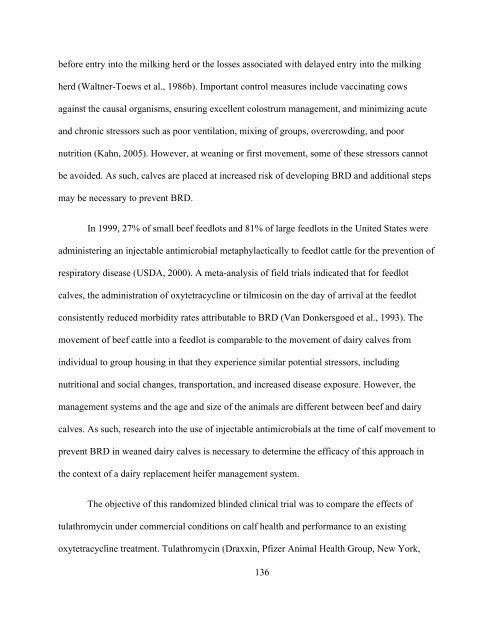Stanton PhD Thesis final_docx - Atrium - University of Guelph
Stanton PhD Thesis final_docx - Atrium - University of Guelph
Stanton PhD Thesis final_docx - Atrium - University of Guelph
You also want an ePaper? Increase the reach of your titles
YUMPU automatically turns print PDFs into web optimized ePapers that Google loves.
efore entry into the milking herd or the losses associated with delayed entry into the milking<br />
herd (Waltner-Toews et al., 1986b). Important control measures include vaccinating cows<br />
against the causal organisms, ensuring excellent colostrum management, and minimizing acute<br />
and chronic stressors such as poor ventilation, mixing <strong>of</strong> groups, overcrowding, and poor<br />
nutrition (Kahn, 2005). However, at weaning or first movement, some <strong>of</strong> these stressors cannot<br />
be avoided. As such, calves are placed at increased risk <strong>of</strong> developing BRD and additional steps<br />
may be necessary to prevent BRD.<br />
In 1999, 27% <strong>of</strong> small beef feedlots and 81% <strong>of</strong> large feedlots in the United States were<br />
administering an injectable antimicrobial metaphylactically to feedlot cattle for the prevention <strong>of</strong><br />
respiratory disease (USDA, 2000). A meta-analysis <strong>of</strong> field trials indicated that for feedlot<br />
calves, the administration <strong>of</strong> oxytetracycline or tilmicosin on the day <strong>of</strong> arrival at the feedlot<br />
consistently reduced morbidity rates attributable to BRD (Van Donkersgoed et al., 1993). The<br />
movement <strong>of</strong> beef cattle into a feedlot is comparable to the movement <strong>of</strong> dairy calves from<br />
individual to group housing in that they experience similar potential stressors, including<br />
nutritional and social changes, transportation, and increased disease exposure. However, the<br />
management systems and the age and size <strong>of</strong> the animals are different between beef and dairy<br />
calves. As such, research into the use <strong>of</strong> injectable antimicrobials at the time <strong>of</strong> calf movement to<br />
prevent BRD in weaned dairy calves is necessary to determine the efficacy <strong>of</strong> this approach in<br />
the context <strong>of</strong> a dairy replacement heifer management system.<br />
The objective <strong>of</strong> this randomized blinded clinical trial was to compare the effects <strong>of</strong><br />
tulathromycin under commercial conditions on calf health and performance to an existing<br />
oxytetracycline treatment. Tulathromycin (Draxxin, Pfizer Animal Health Group, New York,<br />
136

















